Abstract
As part of the restoration project of the 13th century Vera Cruz Church (Segovia, Spain), a preliminary study of the stones used in its construction—dolostones of the Montejo de la Vega Fm of Santonian age (Upper Cretaceous)—and the possible location of the quarry of the provenance of these stones was carried out. For this purpose, a comparative analysis was performed between the currently active quarry of La Vera Cruz n° 88 and the historical quarry of Zamarramala. The samples were characterized using a multidisciplinary approach, combining X-ray diffraction (XRD), polarized optical microscopy (POM), and scanning electron microscopy with microanalysis (SEM-EDX). The combined mineralogical, chemical, and textural characterization provided valuable information on historical provenance. The results show a significant correlation between the dolostone samples obtained from the church and both quarries. The integral characterization confirms the suitability of the dolostones identified in the currently active quarry, Vera Cruz n° 88, for the restoration of the Vera Cruz Church, ensuring the use of appropriate materials. This study contributes to the restoration efforts of the Vera Cruz Church by providing a deeper understanding of the historical origins of the building stones.
1. Introduction
On the occasion of its forthcoming restoration, a multidisciplinary team is conducting a study of the Vera Cruz Church in Segovia, Spain. This research is expected to provide better knowledge before the restoration takes place regarding the compatibility of the stone construction materials and the adequate use of local historical materials.
The research team that will be in charge of the pre-restoration studies [1] includes architects, engineers, historians, archaeologists, and geologists. The role of geosciences is fundamental in this type of study related to stone materials or geomaterials. In particular, it will provide information on the nature of the stones used, their state of conservation, and their provenance. This is relevant to the assessment of the building’s heritage values, both material and non-material, including the complex approach to the concept of authenticity [2].
On the other hand, the physical and mechanical properties of the new materials to be used in the restoration must be studied to ensure maximum compatibility, for which it is essential to determine precisely which of the current quarrying areas can provide a suitable stone [2,3].
This work focuses on the analysis of samples taken from the church, which show visible textural differences and states of conservation. The study aims to provide a comprehensive understanding of the stone. Samples from the nearest and most accessible quarries described in the literature will also be included.
1.1. The Building—History and Former Restorations
The construction of the Vera Cruz Church (Figure 1) dates from the second half of the 12th century to the beginning of the 13th century. Architects and historians do not agree on the military order that founded it, although at present, according to López-Yarto Elizade, it is mostly attributed to the Order of the Holy Sepulchre [4]. From the 14th century until the middle of the 17th century, the church passed into the hands of the Order of Saint John of Jerusalem [5]. In 1663, a period of gradual abandonment began until 1835 when it was disentailed. Later, in 1846, the Commission of Monuments of Segovia took charge of the temple. The San Fernando Royal Academy of Fine Arts contributed during this period with some interventions, especially in the occasional tasks of tiling the roof [6].
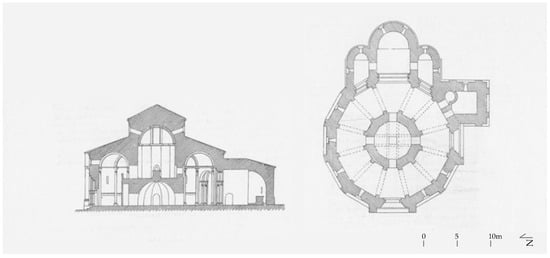
Figure 1.
Floor plan and cross-section of the church, by Vicente Lampérez y Romea in Historia de la Arquitectura Cristiana Española según el estudio de los elementos y los monumentos (1930) [7].
Between 1946 and 1949, the church underwent consolidation and restoration work. The project was designed by Cabello y Dodero. An analysis of the state of the masonry was performed, which revealed water leaks inside the building and a large number of fissures in the vaults. The outer walls were in good condition, but the interior layers needed to be cleaned. Externally, the stone corbels on the eaves were deteriorated, and an interesting relief on the side door had practically disappeared, but the rest of the doorways were found to be in good condition and required only minor repairs. In this intervention, the roof and the cornice of stone corbels were restored [8]. The 1949 restoration project for the Vera Cruz Church, also designed by Cabello y Dodero, focused on restoring the interior of the church. The cracks in the walls and the vault were sealed and a concrete ring beam was built. The stone masonry of the interior, which had been repainted and smoked, was cleaned [9].
In 1949, it was given to the Sovereign Military Order of Malta, heir to the Order of the Knights of the Hospital of Saint John of Jerusalem [5]. Since then, every Good Friday, the Knights carry the relic of the Holy Wood in a procession.
1.2. The Building—Description
Vera Cruz is a beautiful and unique building of Romanesque architecture located to the northwest of the city of Segovia, next to the suburb of San Marcos on the way to Zamarramala. It is an isolated building that sits on a promontory from where the eyes can see the Alcazar of the city.
The spatial configuration of the building and its composition are part of a characteristically Romanesque scheme that incorporates a central layout with a triple apse. The floor plan is dodecagonal, with the temple of the Holy Sepulchre in Jerusalem as a reference archetype. In this work, we analyze the stone used in the construction of the outer wall and its two doorways. The stone used in the construction of the building is dolostone, with the exception of three elements made with granite: the first access step to the southern door, two corbels under the tympanum of the western door, and a reinforcement of the buttress of the tower on its southern side. The inclusion of granite is due to specific interventions before the 20th century.
The outer wall is made up of sections that follow a twelve-sided polygonal layout on the extrados, while, on the intrados, the wall follows a circular layout, except for the two sides of the polygon where the doors open, which are also straight panels on the intrados. One of these two doorways faces west and the other south. The geometric ornamentation belongs to different schools [10] where the Norman school predominates [7].
The west doorway (Figure 2a) consists of three pairs of columns topped with capitals and archivolts (a set of arches inscribed on top of each other to form a flared doorway). The first arch is only decorated with a thick architrave on its edge and rests on the doorjambs [11]. Men, birds, and demons embellish the capitals of the six columns. Chevron ornaments adorn the upper and lower parts of the archivolts [12]. The archivolt, which closes the whole, is decorated with a fine square billet (chequers) molding. All of them are framed by a horizontal impost of carved corbels. The carving is very fine and graceful, as Cabello y Dodero points out. The stone used for the doorways is better suited to the needs of a more precise, better quality carving, as it is finer-grained.
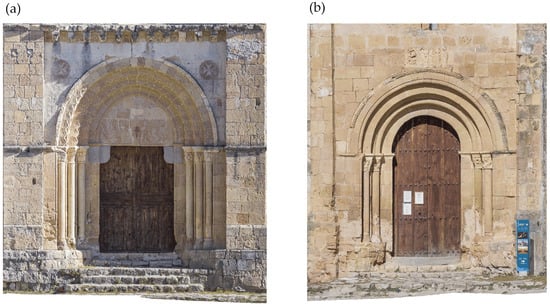
Figure 2.
Church façades: (a) West doorway; (b) South doorway. Orthoimages: Luis-Javier Sánchez-Aparicio.
The south doorway (Figure 2b) is also flared but has only two pairs of semicircular archivolts. These are surmounted by a chequer molding as well. In this doorway, the work on the archivolts and capitals is simpler and the decoration is much less elaborate. Above this door is a bas-relief that was described in the report of the Royal Academy of Fine Arts of San Fernando. It had already deteriorated in 1919, but it was possible to identify a seated monarch or a judge in the act of administering justice on the left side, three standing women on the right, and a tree in the center [4]. This bas-relief is currently in a very advanced state of deterioration (see also Section 1.4 Stone Weathering), which makes it impossible to recognize the iconography described in the report by the San Fernando Royal Academy of Fine Arts for the declaration of a “National Monument” in 1919.
1.3. Geological Setting and Quarries
The literature on comparative studies of quarry and stone heritage samples is very rich. Most of the works show an interest in the location of old quarries in order to know what trade and mining activity was like in ancient times. In some cases, this academic objective is complemented by another of an applied nature: to have a compatible resource for future restoration. Much of the work consulted is based on mineralogical and petrographic studies, using thin sections studied by PLM. The most common is the geochemical study, especially in marbles [13,14], but also in limestones [15,16] and in volcanic rocks [17], with the use of binary diagrams of representative ions and the projection in classical diagrams such as the Total Alkali–Silica (TAS).
Complementary to the use of these mineralogical, petrographic, and chemical techniques, other authors have worked on the comparative study with petrophysical tests, mainly focusing on hydric [18] and mechanical properties through non-destructive testing [19], and even through the correlation of deterioration patterns in the monument and in the quarries [20,21]. In our work, we offer a multi-analytical study with an important presence of SEM-EDX observations to complement the petrographic discussion.
Several quarries have been documented as the source of the materials used in the most important historical buildings in the city of Segovia [22,23,24]. In particular, the Piedra de Bernuy, a fine-grained, compact, yellowish dolostone, and the Piedra del Parral, a fine-grained dolostone with yellow-orange tones and a certain degree of closed porosity described as dolomitic limestone or even as dolomitic sandstone [25]. Both stones come from the same geological area: Dolostones Formation of Montejo de la Vega, Upper Cretaceous (Figure 3). This formation follows the model of the internal carbonate platform of high to medium energy, with a parareciphalic character. The unit is homogeneous and consists mainly of recrystallized dolomite [26].
Historically, the Piedra del Parral has been extracted from various quarry fronts, in search of the banks with the best conditions for its exploitation along the outcrop of the Montejo de la Vega Formation in the cuts of the terrain on the outskirts of Segovia. These outcrops have even been exploited in underground mining, depending on the topography. In the literature, Refs. [22,23,24] describe the areas of the valley of Tejadilla and the Vera Cruz ravine, including those known as ‘Zamarramala’ and ‘Vera Cruz 88’ as the most recent exploitations [24].
In order to accurately locate the quarries in this work, we have followed the methodology initiated by Lazzarini in 1984 for determining the origin of marbles of classical antiquity [27] and adapting it to quarry rocks [28,29,30]. The methodology involves carrying out characterization studies of the materials used in buildings and sites, as well as documentary research. Samples are taken in the field and tested to compare with those of the built element.
According to the bibliography, the masonry used in the construction of the temple came mainly from historical mining areas near the building, especially the Parral and Zamarramala stone quarries [22,31].

Figure 3.
Geological map of the area. To the south (below) is the city of Segovia. To the north (top) is the town of Zamarramala. The black-highlighted building features the Vera Cruz Church. Quarries are marked in red, with the historical Zamarramala quarry on the left and Vera Cruz n° 88 on the right. Both quarries belong to the same geological unit n° 27, identified as ‘Dolostone Formation of Montejo de la Vega’. Figure constructed using cartographic bases BTN25, sheet 35037, from the National Geographical Institute (IGN) [32] and Sheet n° 483 (Segovia) of the Geological Map of Spain, E:1:50.000, second series, 1st edition (MAGNA) [33]. Segovia: 40.94808, −4.11839.
Parral dolostone is quarried at ‘Vera Cruz n° 88’ (Figure 4a), which is still active today, and could be used for the reconstruction of elements in the church. It is an open-cast quarry, although there are traces of underground mining. The terraces are about 10 m high on a slope front about 100 m long [24]. The stone, soft and porous, is suitable for building (Table 1). It is possible that the stones in Vera Cruz come from different strata and quarry faces.
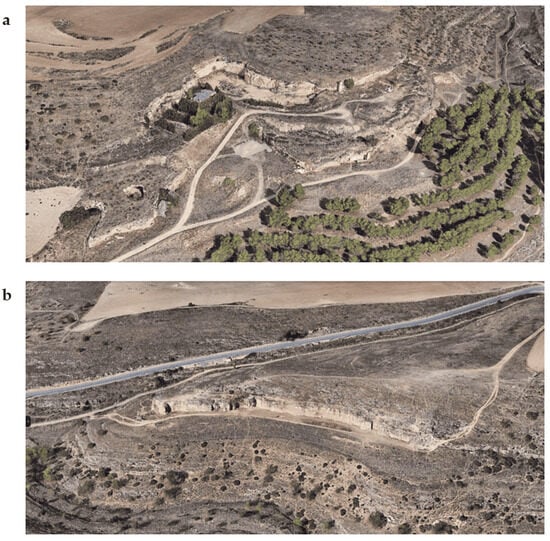
Figure 4.
(a) Active quarry of Vera Cruz n° 88. (b) Historical quarry of Zamarramala. Source: Google Earth [34].

Table 1.
Physical and mechanical properties of Parral dolostone. Adapted from García and Báez (1994) [25].
It is a fine-grained, cream-colored dolomite with some centimetric-sized cavities on the surface. It has undergone a strong dolomitization process. Its dolomite content is between 75% and 95%. The content of siliciclastic components of quartz grains and potassium feldspar can reach 10%, with an average size of 1 mm. Its crystalline texture is very homogeneous, with crystals of rhombic sections quite euhedral and zoned [22].
Porosity can be observed macroscopically and involves the formation of cavern-type macropores that do not communicate with each other. Microscopically, secondary porosity of the moldous type is observed due to the dissolution of bioclasts [22,24].
As for the Zamarramala quarry (Figure 4b), it is also an open-cast quarry with traces of underground extraction and with better-quality fronts [24]. It was exploited in search of a stone with a finer grain size and lighter color, considered to be of better quality for carving.
1.4. Stone Weathering
In order to gain a better understanding of the material, an initial conservation assessment was conducted. This assessment makes possible a better understanding of the current condition of the stone and its behavior in its environment, as well as better decision-making regarding preventive measures and future interventions.
Following the terminology proposed by ICOMOS [35], alterations are identified in all the categories described in the Glossary, as visually illustrated in Figure 5.
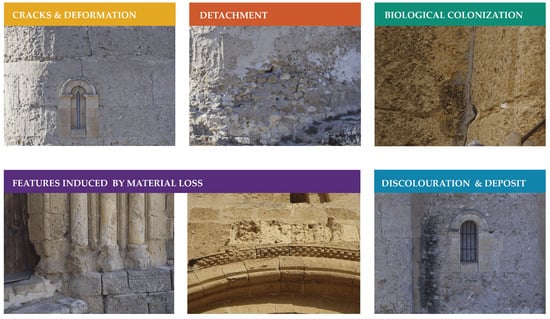
Figure 5.
Stone weathering following ICOMOS terminology.
Fracture-type cracks are observed in the masonry and are particularly evident in the apses (west façade) and interior vaults. As a result of the accumulation of water and unfortunate interventions, detachments in the form of fragmentation can be seen in the base area and in the masonry.
The predominant alteration observed in the monument is material loss. There is pitting (unconnected cavities) in the contact zones between the granite steps and the dolostone on the south façade [22]. In addition, interconnected cavities in the form of alveolization are prevalent. Discoloration and deposits associated with damp conditions are particularly concentrated on the base and roof, giving rise to efflorescence and soiling.
Biological colonization of spores within dolostone pores causes cracking upon germination. Low intracrystalline porosity potentially hinders fungal penetration into the crystal, so they are located in spaces between dolomitic crystals. Fungi are predominantly associated with altered zones, both on the surface and in the interior [31]. In addition, plants are also found on the outer walls.
2. Materials and Methods
2.1. Materials
Eleven stone samples were taken from the Vera Cruz Church as well as one from each of the historical quarries (one from Zamarramala and one from Vera Cruz n° 88). Table 2 shows their location and the nomenclature used for their identification.

Table 2.
Location of the samples. X: Characterization techniques used, and group assignation. S: south façade, E: east façade, and W: west façade.
Ten samples were taken from the outside of the church (Figure 6) (east façade: VC-P-18; south façade: VC-P-1; VC-P-2; VC-P-3; VC-P-5; and VC-P-7; and west façade: VC-P-9; VC-P10; VC-P-13; and VC-P-14) and one from the interior (VC-P-20) in the altar area. These samples were extracted and analyzed, in accordance with the principles of minimum intervention and maximum conservation of the original materials, following the characterization sequences recommended by the ICOMOS Natural Stone Committees [35].
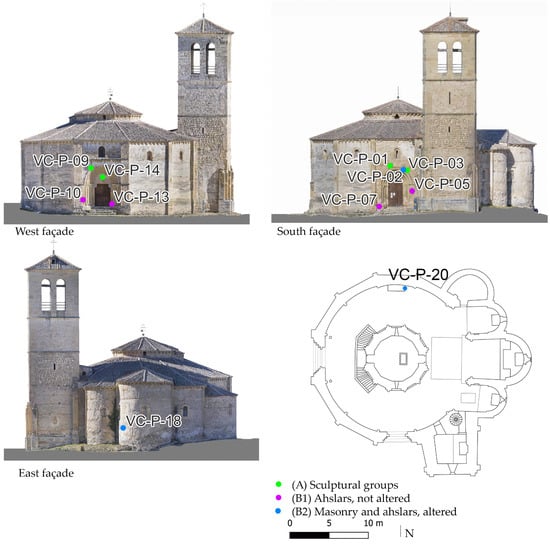
Figure 6.
Location of samples in the outside of the building. East façade: VC-P-18 (Apse). South façade: VC-P-1 (sculptural ensemble on the door); VC-P-2 (decorations on the door); VC-P-3 (ashlar facing above the door); VC-P-5 (Impost); and VC-P-7 (Baseboard). West façade: VC-P-09 (decorations above the door); VC-P-10 (Ashlar on the baseboard); VC-P-13 (inner part of the ashlar on the baseboard); and VC-P-14 (Sculptural ensemble in the door). Interior: VC-P-20 (Altar). Orthoimages: Luis-Javier Sánchez-Aparicio. Layout: Diego Vicente Sánchez.
The sample from the active quarry Vera Cruz n° 88 (VC-01) was taken from an active layer, while Zamarramala’s sample (Z-01) was taken from the remains of the historical quarry.
2.2. Methods
The proposed methodology combines X-ray diffraction (XRD), polarized optical microscopy (POM), and scanning electron microscopy with microanalysis (SEM-EDX) techniques, which are best suited for compositional and deterioration studies [1,36].
The BRUKER D8 ADVANCE diffractometer is used to obtain the X-ray diffraction data for mineralogical identification. Disoriented powder diffraction patterns of the whole sample were obtained using an angular range from 2° to 65°, a step size of 0.02°, a time per step of 1 s, and KαCu radiation. A representative and homogeneous fraction of the samples was ground and sieved at 53 μm. The relative proportions of each crystalline phase (semi-quantitative analysis) were carried out using the Chung method (1975) [37] and BRUKER’s EVA software 13.0.
The petrographic analysis was conducted using optical polarization microscopy on a ZEISS Axiolab 5 microscope with image capture using an Axiocam 208 Color camera. For the petrographic study, the samples selected from the church (VC-P-7, VC-P-9, and VC-P-18) and the two from the quarries (VC-01 and Z-01) were prepared in thin sections.
Morphological and textural observations and microanalysis (SEM-EDX) have been performed on a TESCAN Vega 4 (high/low vacuum) scanning electron microscope equipped with two Bruker EDX detectors with an accelerating voltage of 20 kV. Samples were prepared in fresh fracture and coated with Au (Cressington 108) to ensure good conductivity to the electron beam.
In order to optimize the analytical process and obtain the best results, all samples were subjected to XRD. They were grouped according to their composition, and the most representative of each group was selected to perform SEM and POM. Table 2 shows the samples and the techniques used to characterize them.
This process was carried out by the Geological Techniques Unit of the Research Support Centre in Earth Sciences and Archaeometry of the Complutense University of Madrid (Spain).
3. Results and Discussion
3.1. X-ray Diffraction (XDR)
XRD was used to characterize the mineralogy. Figure 7 shows the minerals present and their percentages.
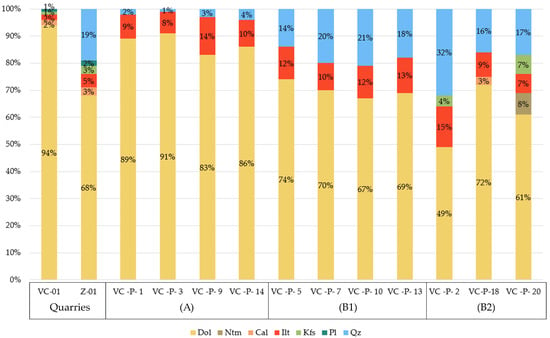

Figure 7.
Mineralogical identification and quantification in %. XDR patterns of quarries and diffractogram of representative samples with identification of the principal peak phases. Abbreviations after Whitney and Evans [38] and Cardell Fernández [39]: Dol (Dolomite), Cal (Calcite), Ilt (Clay Minerals/Illite), Kfs (Potassium feldspar), Pl (Plagioclase), Qz (Quartz), Ntm (Nitromagnesite).
All samples have dolomite as the predominant crystalline phase, with percentages ranging from 49% to 91% in the church samples, 94% in the Vera Cruz quarry, and 68% in the Zamarramala quarry, with smaller proportions of quartz and clay minerals. All of them are classified as dolostones.
The dolostones from the nearby quarries differ in composition. For example, the sample from the active quarry of Vera Cruz is a dolostone of high purity (94%), with no quartz detectable by XRD, and with clay minerals, potassium feldspar, plagioclase, and calcite in proportions of less than 2%. The sample from the historical quarry of Zamarramala has a significantly lower dolomite content of 69%. It has 19% quartz and, as in the previous case, has the same accessory minerals in slightly higher percentages, up to 5%.
Based on their quartz content, the samples from the church are categorized into two groups. The first group (A) includes samples with a lower percentage of quartz (1%–4%), consisting of VC-P-1, VC-P-3, VC-P-9, and VC-P-14. These samples were taken from sculptural groups on the façade (see Figure 6).
The second group (B), made up of the remaining samples, has a quartz content from about 15% to 30%. These correspond to those taken from the ashlars. According to the sampling location and their visually appreciated decay, two different subgroups are established. The first subgroup (B1) includes stones taken from the upper parts, where there is minimum or no water accumulation, showing good conditions. These are VC-P-5, VC-P-7, VC-P-10, and VC-P-13. The second subgroup (B2) comprises samples taken from lower areas that are exposed to the effects of wind and water accumulation. VC-P-2, VC-P-18, and VC-P-20 show a higher degree of weathering.
The remaining microscopic analyses were performed on samples from the two quarries and one representative sample from each group. Specifically, VC-P-9 was used for Group A, VC-P-7 for Group B1, and VC-P-18 for Group B2, which was the only option available due to the quantities of the samples.
Samples of group A, with low quartz content, can be considered the most similar to the active quarry of Vera Cruz, although with slight compositional differences, such as the higher dolomite content of the quarry sample (94%) compared to the average value of these samples which is 87%.
Samples from subgroups B1 and B2, with a higher quartz content, are more similar to those from the historical quarry of Zamarramala, which has 19% quartz and 68% dolomite. The stones in these groups have average quartz values of 18% and 22%, and dolomite values of 70% and 61%, respectively.
3.2. Mineralogical Characterization by Polarizing Optical Microscopy (POM) and Scanning Electron Microscopy (SEM-EDX)
POM on thin sections and fresh fracture SEM-EDX of the representative samples facilitated the characterization of the dolostones. To allow comparison of the different samples, microphotographs were taken at the same magnification (50× and 100×) on representative areas of the thin sections. A magnification of 100× and 1000× was utilized on the fresh fracture. Figure 8 and Figure 9 show the microphotographs taken with optical and electron microscopes, respectively, of the quarry samples, VC-01 and Z-01.
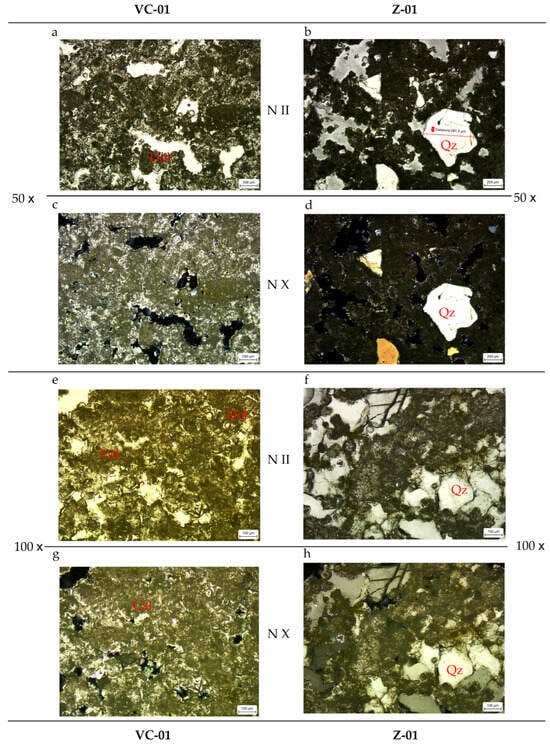
Figure 8.
Representative thin section of the quarry’s samples VC-01 and Z-01. (a) VC-01, 50× magnification parallel nicols; (b) Z-01, 50× magnification parallel nicols; (c) VC-01, 50× magnification crossed nicols; (d) Z-01, 50× magnification crossed nicols; (e) VC-01, 100× magnification parallel nicols; (f) Z-01, 100× magnification parallel nicols; (g) VC-01, 100× magnification crossed nicols; and (h) Z-01, 100× magnification crossed nicols.
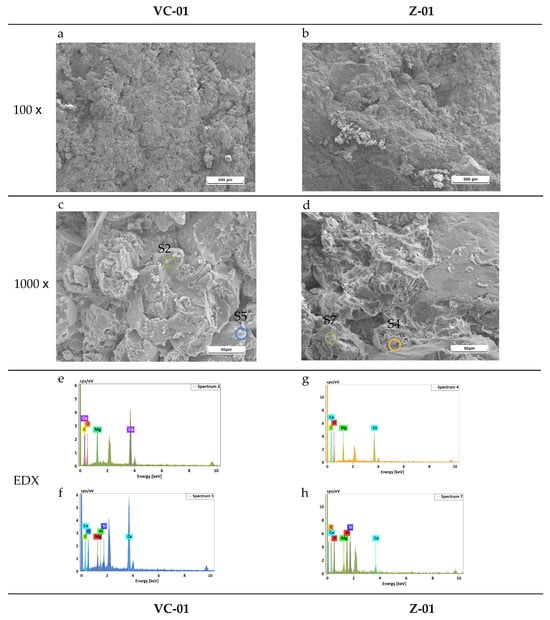
Figure 9.
Scanning microscopy images, secondary electrons at 20 kV. (a) VC-01, 100× magnification; (b) Z-01, 100× magnification; (c) VC-01, 1000× magnification. S2 and S5: Spectrum 2 and 5 (e and f); (d) Z-01, 1000× magnification. S4 and S7: Spectrum 4 and 7 (g and h); (e) EDX analysis on VC-01, 1000×, SE. Spectrum 2 (S2): dolomite; (f) EDX analysis on VC-01, 1000×, SE. Spectrum 5 (S5): clay minerals; (g) EDX analysis con Z-01, 1000×, SE. Spectrum 4 (S4): dolomite and calcite; and (h) EDX analysis con Z-01, 1000×, SE. Spectrum 7 (S7): clay minerals.
POM observations of VC-01 show a uniform matrix composed of recrystallized dolomite crystals (Figure 8a,c,e,g) with a euhedral morphology. The size of the dolomite grains is small (100 μm) in most of the sample. Calcite recrystallizations around the occluded intercrystalline porosity (Figure 8c,g) were observed, as well as the almost complete absence of detrital fragments, mainly quartz. In this sample (Figure 9a,c), the texture appears chaotic and altered, with high porosity. Crystals of dolomite within a clay matrix were identified with EDX analysis (Figure 9e,f). In addition, traces of biological alteration on the grains were found.
Sample Z-01 exhibits a larger grain size in POM with a remarkable presence of anhedral quartz grains up to 600 μm (Figure 8b,d,f,h). On SEM-EDX observation (Figure 9b,d), the sample shows low porosity and minimal surface alteration, characterized by two different quartz grain sizes: large and small ones. EDX analyses (Figure 9g,h) show chemical elements compatible with the presence of quartz, dolomite, clays, and calcite.
As the representative sample of Group A (Figure 10a,d,g,j), VC-P-9 is characterized by POM. Homogeneity and lack of interconnected porosity, with pore sizes of approximately 50 μm, were observed. The absence of quartz is obvious. The dolomite grains have an irregular, fine-grained morphology. SEM-EDX (Figure 11a,d) shows a closed porosity. Well-formed dolomite crystals are observed, as well as recrystallized dolomite. Surface alteration is minimal. EDX analysis indicates the presence of calcium, magnesium, carbon, oxygen, and iron, interpreted as dolomite and iron products of weathering.
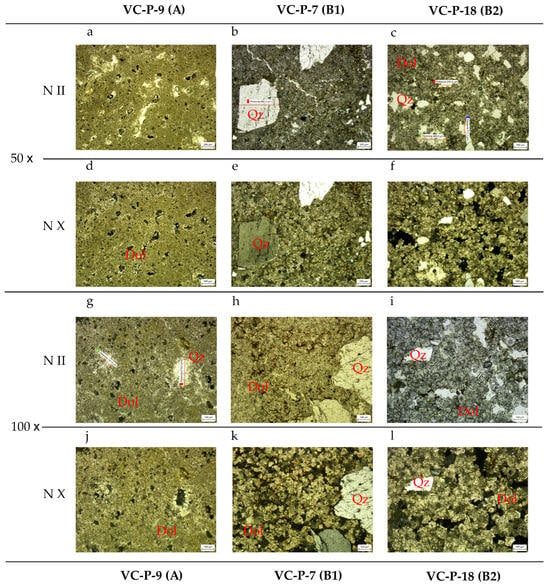
Figure 10.
Thin section of the church’s samples: (a) VC-P-09 (Group A), 50× magnification parallel nicols; (b) VC-P-07 (Group B), 50× magnification parallel nicols; (c) VC-P-18 (Group C), 50× magnification parallel nicols; (d) VC-P-09 (Group A), 50× magnification crossed nicols; (e) VC-P-07 (Group B), 50× magnification crossed nicols; (f) VC-P-18 (Group C), 50× magnification crossed nicols; (g) VC-P-09 (Group A), 100× magnification parallel nicols; (h) VC-P-07 (Group B), 100× magnification parallel nicols; (i) VC-P-18 (Group C), 100× magnification parallel nicols; (j) VC-P-09 (Group A), 100× magnification crossed nicols; (k) VC-P-07 (Group B), 100× magnification crossed nicols; and (l) VC-P-18 (Group C), 100× magnification crossed nicols.
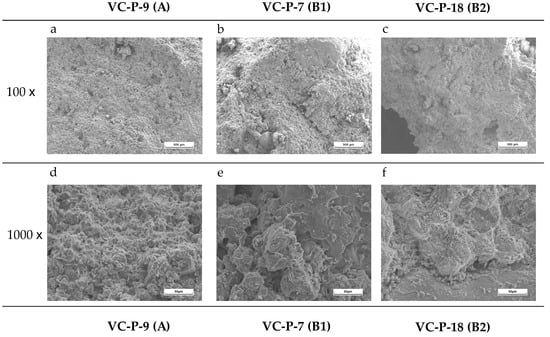
Figure 11.
Electron microscopy images, secondary electrons at 20 kV. (a) VC-P-09, 100× magnification; (b) VC-P-07, 100× magnification; (c) VC-P-18, 100× magnification; (d) VC-P-09, 1000× magnification; (e) VC-P-07, 1000× magnification; (f) VC-P-18, 1000× magnification.
In VC-P-7, from Group B1 (Figure 10b,e,h,k), two different sizes of quartz crystals are observed by optical microscopy. The larger ones measure approximately 600 μm, while the smaller ones measure 100 μm, both exhibiting subhedral morphology. In addition, recrystallization of dolomite about 70 μm in size is observed (Figure 10k). Brownish oxides are presented in the matrix, indicating the weathering of the sample. Two distinct grain textures, one finer and the other larger, are identified by SEM images (Figure 11b,e). The surface texture of altered dolomite crystals shows high porosity and disintegration of the grain matrix, indicative of biological alteration. EDX analyses confirm the presence of clays and dolomite, as well as all the minerals detected by XRD.
VC-P-18, representative of Group B2 (Figure 10c,f,i,l), shows both anhedral and subhedral quartz crystals, measuring around 300 μm, displaying undulating extinction. The dolomite matrix shows a variety of textures and sizes, with recrystallized dolomite. Pronounced intercrystalline and interconnected porosity is evident, accompanied by intracrystalline fungal attack. This sample stands out as the most substantially altered sample examined by POM. In Figure 11c,f, by SEM, the texture appears altered with loose and detached grains in the matrix, resulting in high porosity. Observations include biological alterations on the crystals, disaggregation, and poor adhesion to the matrix. EDX analysis confirms the presence of minerals identified by XRD (quartz, dolomite, and clay), together with biological alteration and iron-related smooth weathering processes.
4. Conclusions
XRD, POM, and SEM-EDX analyses have shown the common origin of all samples: Formation of the Montejo de la Vega dolostones. However, they show significant textural variation in terms of porosity, quartz content, and grain size. This is indicative of formation processes and vertical heterogeneity in the quarry faces.
In this study, samples from the Vera Cruz Church from the late 12th and early 13th centuries were compared with samples obtained from present-day quarry sources. Textural, porosity and grain-size differences found between the two quarry samples may have led to using different material sources for the sculptural and building elements in medieval times. The quarry sources exploited in antiquity no longer exist. The dolostones sampled from the Zamarramala and Vera Cruz n° 88 quarries had similar petrographic characteristics to the church samples.
Group A dolostones, characterized by low quartz content (1%–4%), high dolomite purity (87%), fine-grained texture, and low unconnected porosity, and associated with sculptural groups, are more similar to sample VC-01, taken from the active quarry of Vera Cruz n° 88.
Samples of groups B1 and B2, with quartz contents between 15% and 30%, show two grain sizes (600 μm and 100 μm), lower dolomite purity (average 66%), and higher porosity. They showed similarities to sample Z-01, obtained from the historical quarry of Zamarramala. In particular, Group B2 samples, unlike those of Group B1, are located in areas more exposed to environmental conditions, that cause physical, mechanical, and biological alteration.
Stones from the Vera Cruz n° 88 quarry, the characteristics of which were studied in VC-01, would be suitable for the restoration efforts within the Vera Cruz Church.
Author Contributions
Conceptualization, D.S.-A., M.R.-E., B.d.R.-C. and S.L.-A.; methodology, D.S.-A., M.R.-E. and S.L.-A.; writing—original draft preparation, D.S.-A., M.R.-E., B.d.R.-C. and S.L.-A.; writing—review and editing, D.S.-A., M.R.-E., B.d.R.-C. and S.L.-A. All authors have read and agreed to the published version of the manuscript.
Funding
This research was funded by the research contract of the Fundación General de la Universidad Politécnica de Madrid, n° 43824812127 “FHOME—Iglesia de la Vera Cruz de Segovia”. Supporting: Análisis e intervención en Patrimonio Arquitectónico (AIPA, UPM) y Técnicas Cristalográficas y Geológicas: Aplicaciones no convencionales (UCM).
Data Availability Statement
The raw data supporting the conclusions of this article will be made available by the authors on request.
Acknowledgments
The authors would like to thank the Geological Techniques Unit of the Support Centre for Research in Earth Sciences and Archaeometry of the Complutense University of Madrid (Spain) and the “Servicio General de Apoyo a la investigación-SAI, Universidad de Zaragoza”. We thank data and quarries sample support: Blanca Berenguer de Icaza, Andrés Camino Gómez, Carlos Méndez Moreno, and Pablo Rubio Gimeno. We also thank Fundación Hospitalaria de la Orden de Malta España for allowing sample collection and Luis Javier Sánchez Aparicio and Diego Vicente Sanchez for orthoimages and layouts.
Conflicts of Interest
The authors declare no conflict of interest.
References
- Palma Crespo, M.; Sánchez Aparicio, L.J.; Sanz Arauz, D.; Blanco García, F.; García Morales, S.; López-Cuervo Medina, S.; Maté González, M.A.; Mayo Corrochano, C.; Mencías Carrizosa, D.; Villanueva Llauradó, P. The Church of Vera Cruz in Segovia. A metholodogical proposal for its study. In Proceedings of the Libro de actas: II Simposio de patrimonio cultural ICOMOS, Cartagena, Spain, 17 December 2022. [Google Scholar]
- Roca, P. The Iscarsah Guidelines on the Analysis, Conservation and Structural Restoration of Architectural Heritage. In Proceedings of the 12th International Conference on Structural Analysis of Historical Constructions (SAHC), Barcelona, Spain, 16–18 September 2020. [Google Scholar]
- Přikryl, R. Understanding the Earth scientist’s role in the pre-restoration research of monuments: An overview. Geol. Soc. Lond. Spec. Publ. 2007, 271, 9–21. [Google Scholar] [CrossRef]
- López-Yarto Elizalde, A. La iglesia de la Vera Cruz de Segovia a través de los dibujos de José María Avrial y Flores. Anástasis 2012, 4, 7–16. [Google Scholar]
- Merino de Cáceres, J.M. La Iglesia de la Vera-Cruz de Segovia; Academia de Historia y Arte de San Quirce: Segovia, Spain, 1998. [Google Scholar]
- Abril, L.F.; Vela-Cossío, F. (Gabinete de proyectos arqueológicos, S.L., Madrid, Spain). Proyecto de intervención arqueológica. Iglesia de la Vera Cruz. Unpublished work. 2022. [Google Scholar]
- Lampérez y Romea, V. Historia de la Arquitectura Cristiana Española Según el Estudio de los Elementos y los Monumentos, 2nd ed.; Espasa Calpe: Madrid, Spain, 1930; Volume 1, pp. 89–90, 436. [Google Scholar]
- Cabello y Dodero, F.J. Obras de Consolidación de la Iglesia de la Vera Cruz, Segovia; AGA26/383-003, Architectural Project; Archivo General de la Administración: Madrid, Spain, 1946. [Google Scholar]
- Cabello y Dodero, F.J. Proyecto de restauración de la iglesia de la Vera Cruz, Segovia; AGA 26/383-006, Architectural Project; Archivo General de la Administración: Madrid, Spain, 1949. [Google Scholar]
- Ministerio de instrucción pública y bellas artes. Informe de la Real Academia de la historia. Gaceta Madrid 1919, 220, 475–480. [Google Scholar]
- Cabello y Dodero, F.J. La iglesia de la Vera Cruz. Estudios Segovianos 1951, 3, 425–448. [Google Scholar]
- Quadrado, J.M. España. Sus Monumentos y artes. Su Naturaleza e Historia. Salamanca, Ávila y Segovia; Establecimiento Tipográfico de Daniel Cortezo: Barcelona, Spain, 1884. [Google Scholar]
- Melfos, V. Green Thessalian stone: The byzantine quarries and the use of a unique architectural material from the Larisa area, Greece. Petrographic and geochemical characterization. Oxf. J. Archaeol. 2008, 27, 387–405. [Google Scholar] [CrossRef]
- Ferrini, V.; De Vito, C.; Mignardi, S.; Venanzio Fucinese, D. Archaeological carved slabs of the Langobard art in churches of Peligna Valley and Spoleto (Italy): Provenance of the stones. J. Archaeol. Sci. 2012, 39, 3505–3515. [Google Scholar] [CrossRef]
- Ding, Y.; Mirao, J.; Redol, P.; Dias, L.; Moita, P.; Angelini, E.; Grassini, S.; Schiavon, N. Provenance study of the limestone used in the construction and restoration of the Batalha Monastery (Portugal). Acta IMEKO 2021, 10, 122–128. [Google Scholar] [CrossRef]
- Gökçe, M.V.; İnce, I.; Okuyucu, C.; Doğanay, O.; Fener, M. Ancient Isaura quarries in and around Zengibar Castle (Bozkır, Konya), Central Anatolia, Turkey. Geoheritage 2020, 12, 1–10. [Google Scholar] [CrossRef]
- Dilaria, S.; Bonetto, J.; Germinario, L.; Previato, C.; Girotto, C.; Mazzoli, C. The stone artifacts of the National Archaeological Museum of Adria (Rovigo, Italy): A noteworthy example of heterogeneity. Archaeol. Anthropol. Sci. 2024, 16, 14. [Google Scholar] [CrossRef]
- Ajanaf, T.; Goméz-Gras, D.; Navarro, A.; Martín-Martín, J.D.; Rosell, J.R.; Maate, A. The building stone of the Roman city of Lixus (NW Morocco): Provenance, petrography and petrophysical characterization. Geol. Acta 2020, 18, 1–16. [Google Scholar] [CrossRef]
- Aksoy, R.; İnce, İ.; Mimiroğlu, İ.M.; Esen, Ö. Provenance and geological and geomechanical properties of building stones used in the construction of the Lyrbe ancient city (Manavgat, Antalya, Turkey). Environ. Earth Sci. 2021, 80, 789. [Google Scholar] [CrossRef]
- Martínez-Martínez, J.; Corbí, H.; Martin-Rojas, I.; Baeza-Carratalá, J.F.; Giannetti, A. Stratigraphy, petrophysical characterization and 3D geological modelling of the historical quarry of Nueva Tabarca Island (western Mediterranean): Implications on heritage conservation. Eng. Geol. 2017, 231, 88–89. [Google Scholar] [CrossRef]
- Corbí, H.; Martínez-Martínez, J.; Martin-Rojas, I. Linking geological and architectural heritage in a singular Geosite: Nueva Tabarca Island (SE Spain). Geoheritage 2019, 11, 703–716. [Google Scholar] [CrossRef]
- Vegas Salamanca, J. El Cretácico en la Provincia de Segovia: Caracterización y Degradación de Rocas Ornamentales y de Cantería, 1st ed.; Obra Social y Cultural de Caja Segovia: Segovia, Spain, 1998. [Google Scholar]
- Herrero, A.D. El empleo de las rocas y los minerales en la arquitectura románica de la provincia de Segovia. In Segovia: Enciclopedia del románico en Castilla y León; Centro de Estudios del Románico: Segovia, Spain, 2007. [Google Scholar]
- González, F.P. Caracterización Petrográfica y Petrofísica de la Piedra Monumental en la Provincia de Segovia. Ph.D. Thesis, Universidad de Castilla-La Mancha, Ciudad Real, Spain, 2016. [Google Scholar]
- García de los Ríos Cobo, J.I.; Baez Mezquita, J.M. La piedra en Castilla y León; Junta de Castilla y Leon: Valladolid, Spain, 1994. [Google Scholar]
- Alonso, A. El cretáCico en la Provincia de Segovia (Borde Norte del Sistema Central). Ph.D. Thesis, Universidad Complutense, Madrid, Spain, 1981. [Google Scholar]
- Lazzarini, L. Archaeometric aspects of white and coloured marbles used in antiquity: The state of the art. Periodico Mineralogia 2004, 73, 113–125. [Google Scholar]
- Gómez-Heras, M.; Fort González, R. Localización de canteras de materiales no tradicionales en la arquitectura de Madrid: La Cripta de la Catedral de Santa María la Real de la Almudena. Mater. Constr. 2004, 54, 27. [Google Scholar] [CrossRef]
- Freire Lista, D.M.; Fort González, R. Stone provenance and conservation of the Trinitarias Descalzas of San Ildefonso convent, Madrid (Spain). Ge-Conservación 2017, 11, 42. [Google Scholar] [CrossRef][Green Version]
- Fernández Suarez, J.; Álvarez Areces, E.; Baltuille Martín, J.M.; Martínez Martínez, J. The INCHaPA project: Methodology for the study of historical quarries associated with the architectural heritage. In Recursos Minerales y Medioambiente: Una Herencia que Gestionar y un Futuro que Construir; Álvarez Garcia, R., Ordóñez Alonso, A., Eds.; Universidad de Oviedo, Servicio de Publicaciones: Oviedo, Spain, 2020; pp. 141–151. [Google Scholar]
- Cámara Gallego, B.; Ríos, A.D.L.; García del Cura, M.; Galván, V.; Ascaso, C. Biorreceptividad de las dolomías a la colonización fúngica. Mater. Constr. 2008, 58, 113–124. [Google Scholar]
- BTN 2022–2023 CC-BY 4.0 Instituto GeográFico Nacional (IGN). Available online: https://centrodedescargas.cnig.es/CentroDescargas/catalogo.do?Serie=ME200# (accessed on 1 November 2023).
- Arenas Martín, R.; Fuster, J.M.; Martínez-Salanova, J.; del Olmo Sanz, A.; Villaseca, C. Mapa Geológico y Memoria de la Hoja n° 483 (Segovia). Mapa Geológico de España. E. 1:50.000, Segunda Serie (MAGNA), 1st ed.; ITGE: Madrid, Spain, 1991. [Google Scholar]
- Google Earth. Available online: https://earth.google.com/web/@40.95781388,4.13095852,974.90303654a,1543.8780628d,35y,-6.54646643h,61.51004454t,0r/data=OgMKATA (accessed on 7 December 2023).
- Vergès-Belmin, V. Illustrated Glossary on Stone Deterioration Patterns; ICOMOS-ISCS: Charenton-le-Pont, France, 2011; Volume 15. [Google Scholar]
- Lara, M.L.; Sanz-Arauz, D.; López-Andrés, S.; Pino, I.D. Characterization and Analysis of the Mortars in the Church of the Company of Jesus—Quito (Ecuador). Minerals 2021, 11, 781. [Google Scholar] [CrossRef]
- Chung, F.H. Quantitative Interpretation of X-ray Diffraction Patterns of Mixtures. III. Simultaneous Determination of a Set of Reference Intensities. J. Appl. Crystallogr. 1975, 8, 17–19. [Google Scholar] [CrossRef]
- Whitney, D.L.; Evans, B.W. Abbreviations for Names of Rock-Forming Minerals. Am. Mineral. 2010, 95, 185–187. [Google Scholar] [CrossRef]
- Cardell Fernández, C. Cristalización de sales en Calcarenitas: Aplicación al Monasterio de San Jerónimo, Granada; Universidad de Granada: Granada, Spain, 2003. [Google Scholar]
Disclaimer/Publisher’s Note: The statements, opinions and data contained in all publications are solely those of the individual author(s) and contributor(s) and not of MDPI and/or the editor(s). MDPI and/or the editor(s) disclaim responsibility for any injury to people or property resulting from any ideas, methods, instructions or products referred to in the content. |
© 2024 by the authors. Licensee MDPI, Basel, Switzerland. This article is an open access article distributed under the terms and conditions of the Creative Commons Attribution (CC BY) license (https://creativecommons.org/licenses/by/4.0/).